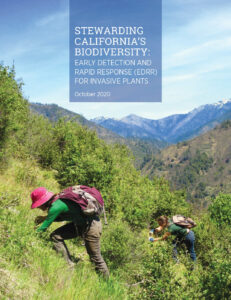
Early Detection Rapid Response (EDRR) is a strategic approach to stopping the spread of invasive plants. Though not complicated conceptually, implementing it effectively at the landscape level is challenging. It requires a high degree of coordination, steady funding over time, and detailed tracking. While California has many important pieces in place, our response to invasive plants is not as strong as it needs to be to protect the state’s biodiversity, agriculture, recreation, water supply and fire safety. This white paper provides background, a description of existing efforts, and recommendations for strengthening the state’s EDRR capacity.
Download the Report
Contents:
Executive Summary
1. The challenge of controlling invasive plants and the need for EDRR
2. The importance of invasive plant EDRR
3. Current status of EDRR for California’s invasive plants
4. How to make EDRR more effective for invasive plants in California
5. Recommendations
6. Conclusion
7. Resources
Please cite this report as: California Invasive Plant Council and California Landscape Stewardship Network. 2020. Stewarding California’s biodiversity: Early detection and rapid response (EDRR) for invasive plants. Cal-IPC Publication 2020-01. California Invasive Plant Council, Berkeley, CA. Available at www.cal-ipc.org and https://calandscapestewardshipnetwork.org.
For more information, contact Cal-IPC.
